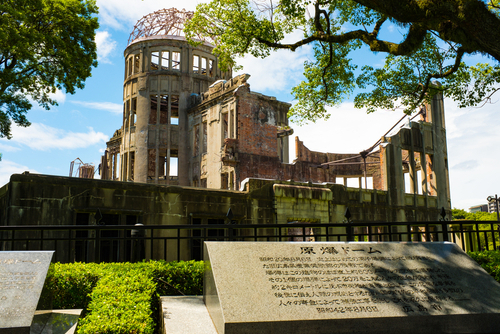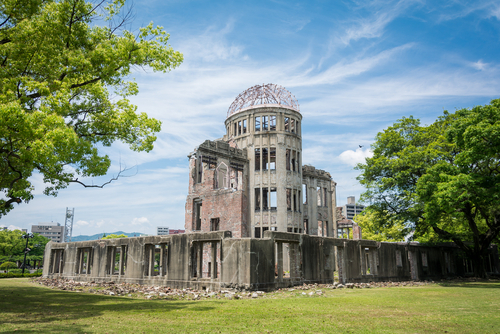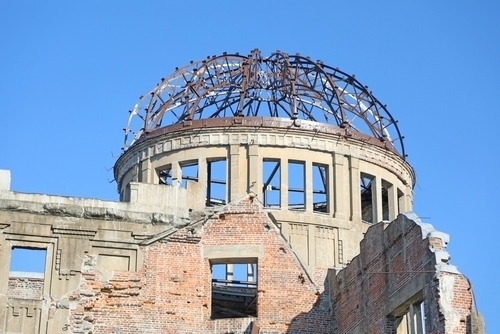What is the Atomic Bomb Dome?
Overview
The Atomic Bomb Dome (原爆ドーム, Genbaku Dōmu) is a historic structure located in Hiroshima City and is recognized as a UNESCO World Heritage Site.
Officially known as the Hiroshima Peace Memorial (広島平和記念碑, Hiroshima Heiwa Kinenhi), it is a preserved remnant of a building destroyed during the atomic bombing of Hiroshima on August 6, 1945. The Atomic Bomb Dome stands as a symbolic reminder of peace and the devastating effects of war.
Historical Background
Originally built in 1915, the building served as the Hiroshima Prefectural Industrial Promotion Hall (広島県物産陳列館, Hiroshima-ken Bussan Chinretsukan). Located about 160 meters from the hypocenter of the explosion, only the central structure survived, while the surrounding areas were completely obliterated. Today, it is a site visited by people from around the world to honor the victims and pray for peace.
Highlights
Building Remains
The skeletal structure of the Atomic Bomb Dome vividly showcases the destructive power of the atomic bomb. Its preserved features, including the dome’s iron framework and cracked walls, serve as important evidence of the bombing’s impact. The circular roof and steel framework led to the structure being referred to as the “Atomic Bomb Dome” by local residents.
Night Illumination
At night, the Atomic Bomb Dome is illuminated, creating a serene and contemplative atmosphere. This event symbolizes peace and hope and is a popular attraction.
Connection to Hiroshima Peace Memorial Park
The Atomic Bomb Dome is surrounded by the expansive Hiroshima Peace Memorial Park (広島平和記念公園, Hiroshima Heiwa Kinen Kōen), which includes other significant landmarks like the Peace Bell (平和の鐘, Heiwa no Kane) and the Memorial Cenotaph for Atomic Bomb Victims (原爆死没者慰霊碑, Genbaku Shibotsusha Ireihi).

Cultural Experiences
Origami Crane Folding
Visitors to Hiroshima Peace Memorial Park can participate in folding origami cranes, a symbol of peace. This hands-on activity is a meaningful way to reflect on and contribute to the message of global harmony.
Japanese Cuisine
Hiroshima’s local delicacies, such as Okonomiyaki (savory pancakes) and Momiji Manju (maple-leaf-shaped sweet cakes), offer visitors a chance to savor the region’s rich culinary culture.
Activities
Cycling Tours
Guided cycling tours around Hiroshima City allow visitors to efficiently explore landmarks like the Atomic Bomb Dome and Hiroshima Peace Memorial Park.
River Cruises
A boat cruise along the Motoyasu River provides unique views of the Atomic Bomb Dome from the water. Evening cruises are particularly recommended for their tranquil ambiance.
FAQs
Can visitors enter the Atomic Bomb Dome?
No, visitors are not permitted to enter the Atomic Bomb Dome. It is preserved as a monument and can only be viewed from the outside.
Nearby Attractions
Miyajima (宮島, Miyajima)
Accessible by train and ferry from Hiroshima, this island features the famous Itsukushima Shrine (厳島神社, Itsukushima Jinja), a UNESCO World Heritage Site.
Hiroshima Castle (広島城, Hiroshima-jō)
Known for its historical significance, Hiroshima Castle is particularly stunning during cherry blossom season and autumn foliage.
Shukkeien Garden (縮景園, Shukkeien)
A traditional Japanese garden in Hiroshima City, Shukkeien is a perfect spot to relax and enjoy the serene environment.

General Information
Access
- Public Transport: Approximately 15 minutes by tram from Hiroshima Station to the “Atomic Bomb Dome-mae” stop.
- On Foot: The site is located within Hiroshima Peace Memorial Park, accessible from the city center.
Admission and Hours
- Admission: Viewing the Atomic Bomb Dome is free. Entrance to the Hiroshima Peace Memorial Museum (広島平和記念資料館, Hiroshima Heiwa Kinen Shiryōkan) costs ¥200 for adults.
- Hours: The park is open 24/7, but the museum operates from 8:30 AM to 6:00 PM.
Official Website
For more details, visit the official website of the Hiroshima Peace Memorial Museum.
Conclusion
The Atomic Bomb Dome is a powerful symbol of “No More Hiroshima” and continues to advocate for the abolition of nuclear weapons and the importance of everlasting peace.



